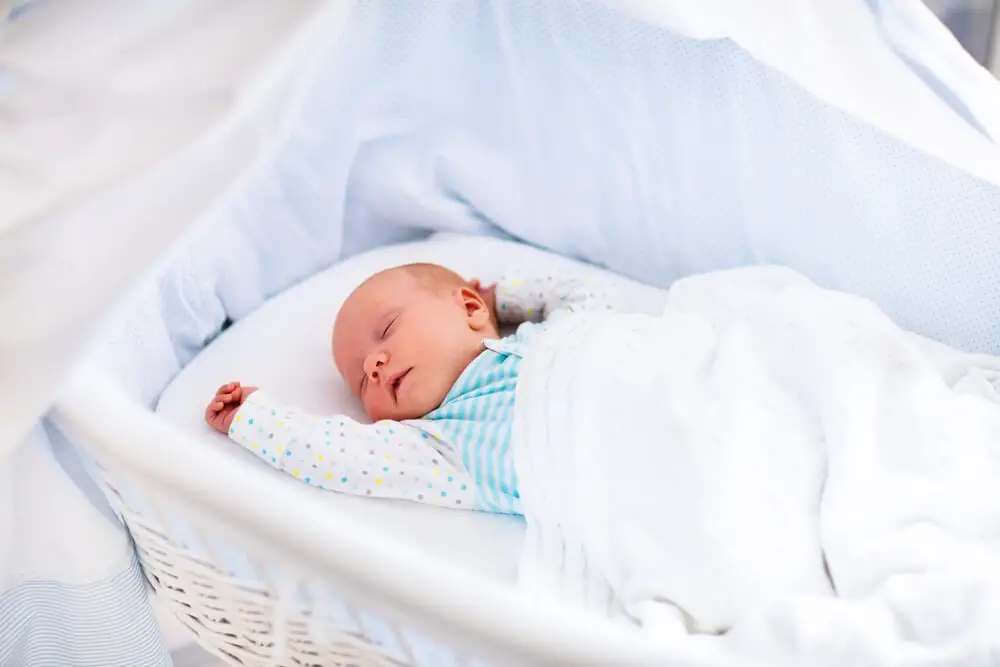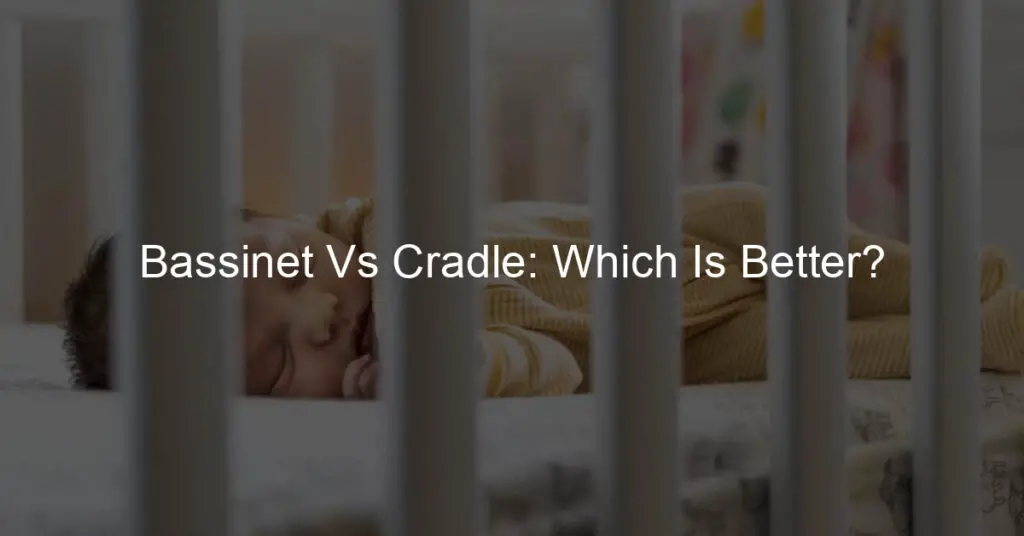Introduction: Bassinet vs Cradle
When it comes to preparing for a new baby, one of the most important decisions you’ll make is choosing where your little one will sleep. Two popular options are bassinets and cradles. But what’s the difference between them, and how do you know which one is right for your family? Let’s dive in and explore.
Understanding the difference between a bassinet and a cradle
A bassinet is a small, portable bed designed for babies from birth until they’re about four months old. They’re lightweight and often come with a hood or cover to protect the baby. On the other hand, a cradle is a small bed that has a rocking or gliding motion, which can help soothe a fussy baby. Cradles are typically used for babies up to six months old.
Importance of choosing the right baby furniture
Choosing the right baby furniture is crucial for your baby’s safety and comfort. It’s not just about aesthetics or price; it’s about ensuring your baby has a safe, comfortable place to sleep. The right choice can also make your life easier, with features like portability and easy cleaning. Whether you choose a bassinet or a cradle, make sure it meets all safety standards and suits your family’s needs.
In the following sections, we’ll delve deeper into the specifics of both bassinets and cradles, providing reviews and comparisons to help you make an informed decision. Remember, the best choice is the one that ensures your baby’s safety and fits into your lifestyle seamlessly.
Bassinet Reviews: An Overview
When it comes to choosing the perfect bassinet for your newborn, there are countless options available. To help you make an informed decision, we’ve compiled a list of our top picks based on quality, safety, and customer reviews.
Best Bassinets: Top Picks
Review of Bassinet 1: The Dream On Me Karley Bassinet
The Dream On Me Karley Bassinet is a top choice for many parents. It’s lightweight, portable, and comes with a double canopy and sleeping pad. The bassinet is designed with a quick folding mechanism, making it easy to transport. The Dream On Me Karley Bassinet is available in several colors, allowing you to choose one that best fits your home decor.
Review of Bassinet 2: The Halo Bassinest Swivel Sleeper
The Halo Bassinest Swivel Sleeper is another excellent option. This bassinet rotates and swivels 360 degrees, allowing you to keep your baby close while in bed. It features a nightlight, three soothing sounds, and three lullabies with volume control, a back to bed reminder, and vibration with a 30-minute auto shutoff. Its sidewall lowers for easy access to the baby, especially useful for nursing mothers and mothers recovering from C-sections.
Review of Bassinet 3: The Fisher-Price Soothing Motions Bassinet
The Fisher-Price Soothing Motions Bassinet is a great choice for parents looking for a bassinet with extra features. It has a soothing sway motion generated by your baby’s movements or with a gentle push from you. The bassinet also features a nightlight, three musical tracks, and two-speed vibration to soothe your baby to sleep.
These top picks are just a starting point in your search for the perfect bassinet. Remember, the best bassinet for your baby depends on your specific needs, lifestyle, and budget. Always consider safety, comfort, and convenience when choosing a bassinet.

Bassinet Features: What to Look For
When choosing a bassinet for your little one, there are several key features to consider. These include the size and portability of the bassinet, the safety features it offers, and any extra features like music or vibration that could enhance your baby’s comfort. Let’s delve into each of these aspects.
Size and Portability
The size of the bassinet is an important factor to consider. It should be compact enough to fit comfortably in your living space, yet spacious enough for your baby to sleep comfortably. Portability is another crucial aspect. A bassinet with wheels or one that’s lightweight can be moved around the house easily, allowing you to keep your baby close at all times.
Safety Features
Safety should always be a top priority when choosing a bassinet. Look for a bassinet with a sturdy frame and a firm, tight-fitting mattress. It should also have mesh sides to promote air circulation and reduce the risk of suffocation. Some bassinets also come with a canopy to shield your baby from light and disturbances. Always ensure the bassinet meets the safety standards set by the Consumer Product Safety Commission.
Extra Features
Extra features can add to the comfort and convenience of a bassinet. Some bassinets come with a vibration feature to soothe your baby to sleep. Others have built-in music or white noise machines to create a calming environment. Some even have a storage basket underneath for keeping baby essentials handy. However, while these features can be beneficial, they should never compromise the safety or comfort of your baby.
In conclusion, when choosing a bassinet, prioritize safety, comfort, and practicality. The right bassinet can make those early months with your newborn a little bit easier and a lot more comfortable.
Bassinet Benefits: Why Choose a Bassinet?
When it comes to choosing a sleeping space for your newborn, a bassinet offers several advantages. Here are some of the key reasons why a bassinet might be the right choice for you and your baby:
Convenience for Parents: Bassinets are designed with parents’ needs in mind. They are lightweight and portable, making it easy to move them from room to room. This means you can keep your baby close by, whether you’re in the living room, kitchen, or bedroom. Plus, many bassinets have a lower height than traditional cribs, so you can easily reach in to soothe or feed your baby without having to get out of bed.
Comfort for the Baby: Bassinets provide a cozy and snug environment that can help your baby feel safe and secure. They are typically smaller than cribs, which can help your baby feel more enclosed and comforted, similar to how they felt in the womb. Some bassinets also come with features like built-in white noise or gentle vibrations to help soothe your baby to sleep.
Space-Saving Design: If you’re short on space, a bassinet can be a great solution. They are smaller than cribs, so they can fit easily in smaller rooms or apartments. Plus, some models can even be folded up when not in use, freeing up even more space.
In conclusion, a bassinet offers a convenient, comfortable, and space-saving solution for your baby’s sleeping needs. It’s a choice that both you and your baby can benefit from.

Cradle Reviews: An Overview
When it comes to choosing the best cradle for your baby, there are many factors to consider. In this section, we will provide an overview of our top picks, highlighting the key features and benefits of each cradle.
Best Cradles: Top Picks
Here are our top three cradle picks, each offering unique features and benefits to ensure your baby’s comfort and safety.
Review of Cradle 1: The Classic Comfort Cradle
The Classic Comfort Cradle is a top choice for many parents. With its sturdy wooden construction and timeless design, this cradle is not only durable but also adds a touch of elegance to any nursery. Its safety features, such as the lockable wheels and adjustable mattress heights, ensure your baby’s safety while providing convenience for parents. Learn more about the Classic Comfort Cradle here.
Review of Cradle 2: The Modern Mobility Cradle
The Modern Mobility Cradle stands out for its innovative design. This cradle features a lightweight yet sturdy frame, making it easy to move around the house. Its mesh sides provide excellent breathability, ensuring your baby’s comfort. The cradle also has a rocking feature, which can help soothe your baby to sleep. Find out more about the Modern Mobility Cradle here.
Review of Cradle 3: The Deluxe Dream Cradle
The Deluxe Dream Cradle is a luxury option for parents who want the best for their baby. This cradle features a plush mattress, soft bedding, and a canopy for added comfort. Its sturdy construction and safety features, including a locking mechanism and anti-tip design, make it a safe and reliable choice. Discover more about the Deluxe Dream Cradle here.
Cradle Features: What to Look For
When shopping for a cradle, there are several key features to consider. These will help ensure that your baby is safe, comfortable, and that the cradle fits well with your home decor. Here are the top three features to look for:
Sturdiness and Durability
A sturdy and durable cradle is a must. It should be able to withstand the weight of your growing baby and the daily wear and tear. Look for a cradle made from high-quality materials like solid wood or metal. These materials are known for their strength and longevity. A durable cradle will not only serve your baby well but can also be passed down to future generations.
Safety Features
Safety should be your top priority when choosing a cradle. Look for a cradle with a sturdy base that won’t tip over easily. The slats should be close enough together to prevent your baby’s head from getting stuck. Also, check for any sharp edges or small parts that could pose a choking hazard. Some cradles also come with safety standards certification, which can give you extra peace of mind.
Design and Aesthetics
While safety and durability are crucial, you also want a cradle that looks good in your home. Cradles come in a variety of styles, from classic to modern, so you’re sure to find one that matches your decor. Consider the color, shape, and overall design of the cradle. Some cradles even come with features like a canopy or a rocking mechanism, adding a touch of charm and functionality.
In conclusion, when choosing a cradle, consider its sturdiness, safety features, and design. A good cradle is not only a safe and comfortable place for your baby to sleep but also a beautiful addition to your home.
Cradle Benefits: Why Choose a Cradle?
When it comes to choosing a sleeping arrangement for your newborn, a cradle offers several unique benefits that make it an excellent choice. Here are some reasons why you might want to consider a cradle:
Longer usage period: Unlike bassinets, cradles can be used for a longer period. This is because they are typically larger and sturdier, allowing them to accommodate your growing baby for up to several months or even a year. This extended usage period can make a cradle a more cost-effective choice in the long run.
Classic, timeless design: Cradles have a classic design that never goes out of style. Their simple, elegant look can complement any nursery decor. Plus, their timeless appeal means they can be passed down through generations as a beautiful family heirloom.
Comfort and security for the baby: Cradles are designed with the comfort and security of your baby in mind. They often feature a rocking or gliding motion that can help soothe your baby to sleep. Plus, their enclosed design can make your baby feel more secure and cozy, promoting better sleep.
In conclusion, a cradle can be a wonderful choice for your baby’s first bed. With its longer usage period, classic design, and focus on comfort and security, a cradle offers many benefits that can make it a worthwhile investment for new parents.
Bassinet vs Cradle Differences: A Comparison
When it comes to choosing between a bassinet and a cradle for your newborn, there are several factors to consider. In this section, we will compare the size and portability, safety features, and design aesthetics of both to help you make an informed decision.
Comparing size and portability
Bassinets are generally smaller and lighter than cradles, making them a more portable option. They are designed to be moved around the house easily, allowing parents to keep their baby close at all times. On the other hand, cradles are larger and heavier, making them less portable but more stable. They are often designed to rock gently, which can help soothe a fussy baby.
Comparing safety features
Both bassinets and cradles come with their own set of safety features. Bassinets often have mesh sides for better airflow and visibility, while cradles usually have solid sides. However, both should have a firm, flat mattress and no gaps where a baby could get trapped. Always check that the product you choose meets the latest safety standards.
Comparing design and aesthetics
The design and aesthetics of bassinets and cradles can vary greatly. Bassinets tend to have a more modern and sleek design, while cradles often feature a more traditional and classic look. The choice between the two will largely depend on your personal preference and the decor of your nursery.
In conclusion, the choice between a bassinet and a cradle will depend on your specific needs and preferences. Consider the size and portability, safety features, and design aesthetics of each before making your decision.
Conclusion: Choosing Between a Bassinet and a Cradle
In the end, the choice between a bassinet and a cradle comes down to your personal preferences, lifestyle, and specific needs. There are several factors to consider when making this decision.
Factors to consider when choosing
When deciding between a bassinet and a cradle, you should consider the size of your home, your budget, and the mobility of the item. A bassinet is usually smaller and more portable, making it a good choice for smaller homes or for parents who travel frequently. On the other hand, a cradle can be a more stable and long-lasting option, but it may require more space and a higher budget.
Personal preferences and lifestyle
Your lifestyle and personal preferences also play a crucial role in this decision. If you prefer a more traditional and vintage look, a cradle might be the right choice for you. If you value portability and modern design, a bassinet could be a better fit. Consider your daily routines and habits as well. If you often move around the house and want your baby close by, a bassinet’s portability can be a significant advantage.
Final thoughts
Ultimately, both bassinets and cradles can provide a safe and comfortable space for your baby to sleep. The decision should be based on what works best for your family and your lifestyle. Remember, the most important thing is that your baby is safe, comfortable, and loved, regardless of whether they sleep in a bassinet or a cradle.
Whether you choose a bassinet or a cradle, make sure it meets all safety standards and is a place where your baby can sleep peacefully and safely. Happy parenting!














